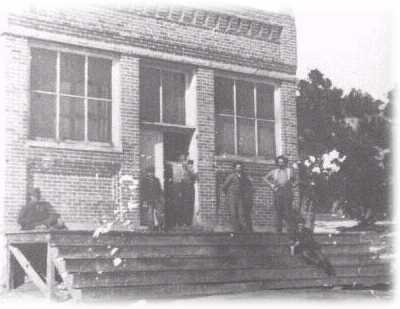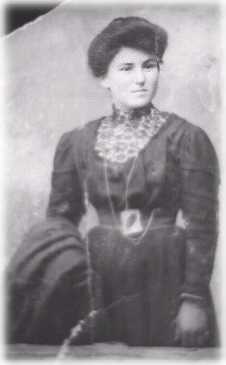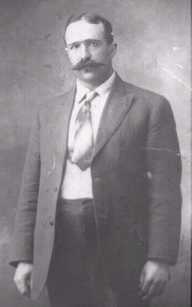arlo Pinamonti, my papa, was born in Rallo, January 9, 1885. At
that time, Rallo was still under Austrian control, and did not become part of Italy until
the end of World War I. This fact helped emigrants to the United States since they avoided
much of the discrimination encountered by Italian emigrants. The Pinamonti family is well known in Rallo. Carlo's grandfather, also Carlo Pinamonti,
and his grandfather's brother don Giuseppe Pinamonti (a priest) promoted the building of
roads and bridges in their area. At this time Carlo was the mayor of Rallo. Don Giuseppe
designed, and with the help of his brother, built an aqueduct in 1852 to bring water from
Lago de Tovel to the Val di Non.There was much opposition to this aqueduct, especially
from those who had rights to control the water supply to certain of the Val di Non
villages. These persons did not want to lose their rights to the water and source of
income. The Pinamonti brothers were also known for their diverse literary works in dialect
(Nonesi) and the Italian language. In 1952 a stone tablet honoring the brothers was placed
on the Pinamonti house in Rallo.
arlo, my papa, came to the United States in 1900 at the age of 15 with his mother, (my grandmother) Carolina (Odorizzi) Pinamonti and his sister Josephine and a brother Abelardo. Carlo's father, Battista (John) Pinamonti, (my grandfather) had come to the US, in 1895 to work in the coal mines of Colorado. He sent for his wife and family five years later. They all came through Ellis Island and New York and on to Trinidad, Colorado by train. From Trinidad, they traveled to Fremont County, Colorado. Coal was first mined in Fremont County, Colorado in 1860, when out-croppings were first discovered in what later became the town of Coal Creek. Until 1927, the camps were booming and the county was prospering and the neighboring towns of Florence and Canon City flourished. The mining camps closed in 1929. The first miners in Fremont County were the Scotch, Welsh and the Irish who had worked in the mines of the British Isles and knew their craft well since they started working in the pits as young as five years of age. The later miners recruited from Italy, Greece, Poland and Mexico were called "Greenies". Most of the Greenies were farmers in their homeland, and were recruited because they were strong and healthy and able to work the long difficult hours. Each ethnic group looked down on the latest arrivals with scorn because of their inexperience. The coal companies encouraged this racism as they could thus pit one group against the other. Since there were no labor unions existing at the mines, the latest recruits usually could be paid a smaller wage, thus causing older miners to lose their jobs. Miners generally lived in wretched camps alongside the coal mines. The coal camps in Fremont County were never as bad as the 'closed camps' in the southern part of Colorado around Walsenburg, where everything was "company owned". However, conditions in the actual mines were bad. The men worked 10 to 12 hour shifts during the winter, and in the summer months the mines were closed, the men and their families lived on vegetables from their gardens and fish from the Arkansas River as their staple. Their annual pay was $350 to $500 per year.
In the early 1920's, the various ethnic groups had forgotten their differences and there was harmony amongst the miners, but by 1921 the Ku Klux Klan, Inc. came to Colorado and extended their influence throughout the state. The governor of Colorado during this time was a member of the Ku Klux Klan. Especially hated were the Jews, Negroes and Catholics. Miners who had been friends for years became distrustful of each other. Some no longer spoke to old friends. Workers applying for jobs had their applications thrown out if their name was not Anglo-Saxon. People changed the spelling of their names to have those names more 'Americanized' even though some of them were second or third generations Americans. The Catholic church in Rockvale (6 miles from Radiant) had it's windows broken and the inside was desecrated. Crosses were burned at night on a hill, facing the Catholic Church in Rockvale. A parade was held in Canon City with 10,000 Klansmen wearing hoods and carrying flaming torches striking fear in most of the miners. The power of the Klan was finally broken as the years passed and by the end of World War II much of the bitterness that had been engendered by the Ku Klux Klan in Colorado was erased.*
arlo and his father worked in the mines for several years. They learned how to do shoring in the Radiant, Colorado coal mines. Life was harsh and they saved their money and eventually opened a saloon in Radiant. The family had a small home in Radiant and also had a small 'ranch' up in the hills away from the coal mining camp and retreated there every summer when the mines were idle. They had a small rock dwelling (house), a still house, outhouse, barn and horses. They used horses and buggies to go to town. One story told to me by a cousin, Angelica (Pinamonti) Kimpton, was that when she was a young teen and she was riding in a horse and buggy with Carlo, from the 'ranch' to the mining camp. Carlo stopped the buggy along the way to let Angelica get out to pick up an empty bucket (the buckets were used to deliver beer) by the side of the dirt road and when she reached down she heard a loud gunshot. She was startled and did not move. She looked close to her hand and saw a dead rattlesnake! She was very thankful that he was a very good marksman. Carlo was well liked by all his cousins and friends and was a very gentle, easy going handsome young man. He was always ready to help those in need. In 1911, Carlo married Josephina Valentini, a pretty young woman of 17. They were only married around a year when she had to have a tooth extracted and died shortly thereafter of blood poisoning. Carlo did not marry again until 9 years later. In 1920, early in the year, my mama Carlotta, sister of Carlo's first wife, Josephine came to America.
She was born in Rallo, Austria, on September 8, 1894. Carlotta was only five years old when Carlo left Rallo. She was a very intelligent pretty young woman. She traveled to the United States all alone, 3rd class (also known as "steerage") which meant that the passengers were generally crammed together in large uncomfortable compartments deep within the ship. The weather was rough at this time of the year and I recall her telling me that before she left Rallo, she and her family had prepared enough food to last for the whole trip. She also told me that many of the passengers became seasick and that the smell of people and vomit was terrible. This must have been quite a trip! She was adventurous and brave to have taken this voyage all alone to go to a new country and possibly marry a man she did not know. We, the children of Carlotta do not know whether the marriage was an arranged marriage. Some of us believe that she was a romanticist and thought she was in love with Carlo possibly from seeing his photograph. Carlotta arrived at Ellis Island, processed through the (to her eyes) maze of questions and examinations, and passed through to go on to New York. She was at the train station trying to find the correct train to Trinidad, Colorado when a man dressed in a uniform came and tried to take her suitcases. She thought that he was trying to steal them from her. It was finally made clear to her that this was the porter for the train and he was only trying to help her get her luggage aboard the train. She was met at the station in Trinidad, Colorado by Carlo and his parents and her sister, Amalia and many other relatives. In May of this same year (1920), Carlotta Valentini married Carlo Pinamonti, in the Holy Trinity Catholic Church in Trinidad, Colorado.
|
|

 These two brothers are remembered in posterity
for their courage and foresight in bringing the water to the Val di Non for agricultural
purposes. Their efforts were partly responsible for the abundant apple orchards and other
crops now found in Val di Non.
These two brothers are remembered in posterity
for their courage and foresight in bringing the water to the Val di Non for agricultural
purposes. Their efforts were partly responsible for the abundant apple orchards and other
crops now found in Val di Non. 



